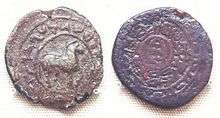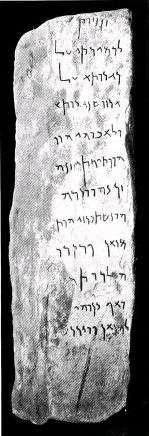Kharosthi
| Kharoṣṭhī | |
|---|---|
| Type | |
| Languages | Gandhari Prakrit |
Time period | 4th century BCE – 3rd century CE |
Parent systems | |
Sister systems |
Brahmi script Nabataean alphabet Syriac alphabet Palmyrene alphabet Mandaic alphabet Pahlavi scripts Sogdian alphabet |
| Direction | Right-to-left |
| ISO 15924 |
Khar, 305 |
Unicode alias | Kharoshthi |
| U+10A00–U+10A5F | |

| Numeral systems |
|---|
 |
| Hindu–Arabic numeral system |
| East Asian |
| Alphabetic |
| Former |
| Positional systems by base |
| Non-standard positional numeral systems |
| List of numeral systems |
The Kharoṣṭhī script is an ancient script used in ancient Gandhara[1] (primarily modern-day Afghanistan and Pakistan) to write the Gandhari Prakrit and Sanskrit. It was popular in Central Asia as well.[1] An abugida, it was in use from the middle of the 3rd century BCE until it died out in its homeland around the 3rd century CE.[1] It was also in use in Bactria, the Kushan Empire, Sogdia and along the Silk Road, where there is some evidence it may have survived until the 7th century in the remote way stations of Khotan and Niya. Kharoṣṭhī is encoded in the Unicode range U+10A00–U+10A5F, from version 4.1.0.

Form
Kharoṣṭhī is mostly written right to left (type A), but some inscriptions (type B) already show the left to right direction that was to become universal for the later South Asian scripts.
Each syllable includes the short /a/ sound by default, with other vowels being indicated by diacritic marks. Recent epigraphical evidence highlighted by Professor Richard Salomon of the University of Washington has shown that the order of letters in the Kharoṣṭhī script follows what has become known as the Arapacana alphabet. As preserved in Sanskrit documents, the alphabet runs:
- a ra pa ca na la da ba ḍa ṣa va ta ya ṣṭa ka sa ma ga stha ja śva dha śa kha kṣa sta jñā rtha (or ha) bha cha sma hva tsa gha ṭha ṇa pha ska ysa śca ṭa ḍha
Some variations in both the number and order of syllables occur in extant texts.
Kharoṣṭhī includes only one standalone vowel sign which is used for initial vowels in words. Other initial vowels use the a character modified by diacritics. Using epigraphic evidence, Salomon has established that the vowel order is /a e i o u/, rather than the usual vowel order for Indic scripts /a i u e o/. That is the same as the Semitic vowel order. Also, there is no differentiation between long and short vowels in Kharoṣṭhī. Both are marked using the same vowel markers.
The alphabet was used in Gandharan Buddhism as a mnemonic for remembering a series of verses on the nature of phenomena. In Tantric Buddhism, the list was incorporated into ritual practices and later became enshrined in mantras.
Alphabet
| 𐨀 a | 𐨁 i | 𐨂 u | 𐨅 e | 𐨆 o | 𐨃 ṛ |
| 𐨐 k | 𐨑 kh | 𐨒 g | 𐨓 gh | |
| 𐨕 c | 𐨖 ch | 𐨗 j | 𐨙 ñ | |
| 𐨚 ṭ | 𐨛 ṭh | 𐨜 ḍ | 𐨝 ḍh | 𐨞 ṇ |
| 𐨟 t | 𐨠 th | 𐨡 d | 𐨢 dh | 𐨣 n |
| 𐨤 p | 𐨥 ph | 𐨦 b | 𐨧 bh | 𐨨 m |
| 𐨩 y | 𐨪 r | 𐨫 l | 𐨬 v | |
| 𐨭 ś | 𐨮 ṣ | 𐨯 s | 𐨱 h |
| 𐨲 ḱ | 𐨳 ṭ́h |

Numerals
| ۱ | ۲ | ۳ | ㄨ | ۱ㄨ | ۲ㄨ | ۳ㄨ | ㄨㄨ | ۱ㄨㄨ |
|---|---|---|---|---|---|---|---|---|
| 1 | 2 | 3 | 4 | 5 | 6 | 7 | 8 | 9 |
| ੭ | Ȝ | ੭Ȝ | ȜȜ | ੭ȜȜ | ȜȜȜ | ੭ȜȜȜ | ||
| 10 | 20 | 30 | 40 | 50 | 60 | 70 | ||
| ʎ۱ | ʎ۲ | |||||||
| 100 | 200 | |||||||
Kharoṣṭhī included a set of numerals that are reminiscent of Roman numerals. The symbols were I for the unit, X for four (perhaps representative of four lines or directions), ੭ for ten (doubled for twenty), and ʎ for the hundreds multiplier. The system is based on an additive and a multiplicative principle, but does not have the subtractive feature used in the Roman number system.[2]
| 𐩀 1 | 𐩁 2 | 𐩂 3 | 𐩃 4 | 𐩄 10 | 𐩅 20 | 𐩆 100 | 𐩇 1000 |
Note that the table beside reads right-to-left, just like the Kharoṣṭhī abugida itself and the displayed numbers.
History

Obv: Greek legend, ΒΑΣΙΛΕΩΣ ΣΩΤΗΡΟΣ ΜΕΝΑΝΔΡΟΥ (BASILEOS SOTEROS MENANDROU), literally, "Of Saviour King Menander".
Rev: Kharosthi legend: MAHARAJA TRATARASA MENADRASA "Saviour King Menander". Athena advancing right, with thunderbolt and shield. Taxila mint mark.


The Kharoṣṭhī script was deciphered by James Prinsep (1799–1840) using the bilingual coins of the Indo-Greek Kingdom (obverse in Greek, reverse in Pali, using the Kharoṣṭhī script). This in turn led to the reading of the Edicts of Ashoka, some of which, from the northwest of South Asia, were written in the Kharoṣṭhī script.

Scholars are not in agreement as to whether the Kharoṣṭhī script evolved gradually, or was the deliberate work of a single inventor. An analysis of the script forms shows a clear dependency on the Aramaic alphabet but with extensive modifications to support the sounds found in Indic languages. One model is that the Aramaic script arrived with the Achaemenid Empire's conquest of the Indus River (modern Pakistan) in 500 BCE and evolved over the next 200+ years, reaching its final form by the 3rd century BCE where it appears in some of the Edicts of Ashoka found in northwestern part of South Asia. However, no intermediate forms have yet been found to confirm this evolutionary model, and rock and coin inscriptions from the 3rd century BCE onward show a unified and standard form. An inscription in Aramaic dating back to the 4th century BC was found in Sirkap, testifying to the presence of the Aramaic script in northwestern India at that period. According to Sir John Marshall, this seems to confirm that Kharoshthi was later developed from Aramaic.[3]

The study of the Kharoṣṭhī script was recently invigorated by the discovery of the Gandhāran Buddhist texts, a set of birch bark manuscripts written in Kharoṣṭhī, discovered near the Afghan city of Hadda just west of the Khyber Pass in modern Pakistan. The manuscripts were donated to the British Library in 1994. The entire set of manuscripts are dated to the 1st century CE, making them the oldest Buddhist manuscripts yet discovered.
|
Egyptian hieroglyphs 32 c. BCE
|
 Coin of Gurgamoya, king of Khotan. Khotan, 1st century CE. Obverse: Kharoshthi legend: "Of the great king of kings, king of Khotan, Gurgamoya. Reverse: Chinese legend: "Twenty-four grain copper coin."
Coin of Gurgamoya, king of Khotan. Khotan, 1st century CE. Obverse: Kharoshthi legend: "Of the great king of kings, king of Khotan, Gurgamoya. Reverse: Chinese legend: "Twenty-four grain copper coin."
Unicode
Kharosthi was added to the Unicode Standard in March, 2005 with the release of version 4.1.
The Unicode block for Kharosthi is U+10A00–U+10A5F:
| Kharoshthi[1][2] Official Unicode Consortium code chart (PDF) | ||||||||||||||||
| 0 | 1 | 2 | 3 | 4 | 5 | 6 | 7 | 8 | 9 | A | B | C | D | E | F | |
| U+10A0x | 𐨀 | 𐨁 | 𐨂 | 𐨃 | 𐨅 | 𐨆 | 𐨌 | 𐨍 | 𐨎 | 𐨏 | ||||||
| U+10A1x | 𐨐 | 𐨑 | 𐨒 | 𐨓 | 𐨕 | 𐨖 | 𐨗 | 𐨙 | 𐨚 | 𐨛 | 𐨜 | 𐨝 | 𐨞 | 𐨟 | ||
| U+10A2x | 𐨠 | 𐨡 | 𐨢 | 𐨣 | 𐨤 | 𐨥 | 𐨦 | 𐨧 | 𐨨 | 𐨩 | 𐨪 | 𐨫 | 𐨬 | 𐨭 | 𐨮 | 𐨯 |
| U+10A3x | 𐨰 | 𐨱 | 𐨲 | 𐨳 | 𐨸 | 𐨹 | 𐨺 | 𐨿 | ||||||||
| U+10A4x | 𐩀 | 𐩁 | 𐩂 | 𐩃 | 𐩄 | 𐩅 | 𐩆 | 𐩇 | ||||||||
| U+10A5x | 𐩐 | 𐩑 | 𐩒 | 𐩓 | 𐩔 | 𐩕 | 𐩖 | 𐩗 | 𐩘 | |||||||
| Notes | ||||||||||||||||
See also
Further reading
References
- 1 2 3 R. D. Banerji (April 1920). "The Kharosthi Alphabet". The Journal of the Royal Asiatic Society of Great Britain and Ireland (2): 193–219. JSTOR 25209596.
- ↑ Graham Flegg, Numbers: Their History and Meaning, Courier Dover Publications, 2002, ISBN 978-0-486-42165-0, p. 67f.
- ↑ A Guide to Taxila, John Marshall, 1918
- Dani, Ahmad Hassan. Kharoshthi Primer, Lahore Museum Publication Series - 16, Lahore, 1979
- Falk, Harry. Schrift im alten Indien: Ein Forschungsbericht mit Anmerkungen, Gunter Narr Verlag, 1993 (in German)
- Fussman's, Gérard. Les premiers systèmes d'écriture en Inde, in Annuaire du Collège de France 1988-1989 (in French)
- Hinüber, Oscar von. Der Beginn der Schrift und frühe Schriftlichkeit in Indien, Franz Steiner Verlag, 1990 (in German)
- Nasim Khan, M.(1997). Ashokan Inscriptions: A Palaeographical Study. Atthariyyat (Archaeology), Vol. I, pp. 131–150. Peshawar
- Nasim Khan, M.(1999). Two Dated Kharoshthi Inscriptions from Gandhara. Journal of Asian Civilizations (Journal of Central Asia), Vol. XXII, No.1, July 1999: 99-103.
- Nasim Khan, M.(2000). An Inscribed Relic-Casket from Dir. The Journal of Humanities and Social Sciences, Vol. V, No. 1, March 1997: 21-33. Peshawar
- Nasim Khan, M.(2000). Kharoshthi Inscription from Swabi - Gandhara. The Journal of Humanities and Social Sciences, Vol. V, No. 2. September 1997: 49-52. Peshawar.
- Nasim Khan, M.(2004). Kharoshthi Manuscripts from Gandhara. Journal of Humanities and Social Sciences. Vol. XII, Nos. 1 & 2 (2004): 9-15. Peshawar
- Nasim Khan, M.(2009). Kharoshthi Manuscripts from Gandhara (2nd ed.. First published in 2008.
- Norman, Kenneth R. The Development of Writing in India and its Effect upon the Pâli Canon, in Wiener Zeitschrift für die Kunde Südasiens (36), 1993
- Salomon, Richard. New evidence for a Gāndhārī origin of the arapacana syllabary. Journal of the American Oriental Society. Apr-Jun 1990, Vol.110 (2), p. 255-273.
- Salomon, Richard. An additional note on arapacana. Journal of the American Oriental Society. 1993, Vol.113 (2), p. 275-6.
- Salomon, Richard. Kharoṣṭhī syllables used as location markers in Gāndhāran stūpa architecture. Pierfrancesco Callieri, ed., Architetti, Capomastri, Artigiani: L’organizzazione dei cantieri e della produzione artistica nell’asia ellenistica. Studi offerti a Domenico Faccenna nel suo ottantesimo compleanno. (Serie Orientale Rome 100; Rome: Istituto Italiano per l’Africa e l’Oriente, 2006), pp. 181–224.
External links
- List of all known Kharoṣṭhī (Gandhārī) inscriptions.
- Information on the Kharoṣṭhī alphabet by Omniglot
- A Preliminary Study of Kharoṣṭhī Manuscript Paleography by Andrew Glass, University of Washington (2000)
- On The Origin Of The Early Indian Scripts: A Review Article by Richard Salomon, University of Washington (via archive.org)
- Proposal to encode Kharoṣṭhī in Unicode (includes good background info)
